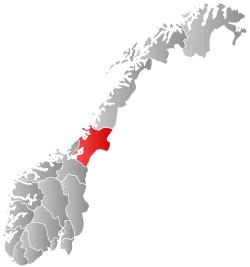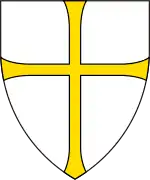Sørli Municipality
Sørli herred | |
|---|---|
 Nord-Trøndelag within Norway | |
 Sørli within Nord-Trøndelag | |
| Coordinates: 64°13′29″N 13°49′51″E / 64.2246°N 13.8308°E | |
| Country | Norway |
| County | Nord-Trøndelag |
| District | Namdalen |
| Established | 1 July 1915 |
| • Preceded by | Lierne Municipality |
| Disestablished | 1 Jan 1964 |
| • Succeeded by | Lierne Municipality |
| Administrative centre | Mebygda |
| Area (upon dissolution) | |
| • Total | 1,435 km2 (554 sq mi) |
| Population (1964) | |
| • Total | 898 |
| • Density | 0.63/km2 (1.6/sq mi) |
| Demonym | Libygg[1] |
| Time zone | UTC+01:00 (CET) |
| • Summer (DST) | UTC+02:00 (CEST) |
| ISO 3166 code | NO-1737[2] |
Sørli is a former municipality in the old Nord-Trøndelag county in Norway. The 1,435-square-kilometre (554 sq mi) municipality existed from 1915 until its dissolution in 1964. The municipality encompassed the southern part of what is now the municipality of Lierne in Trøndelag county. The administrative centre of the municipality was the village of Mebygda.[3]
History
The municipality of Sørli was established on 1 July 1915 when the old municipality of Lierne (Finnlierne) was split in two parts: Nordli (population: 863) in the north and Sørli (population: 739) in the south. The old municipality of Lierne had been created on 1 January 1874 when it was separated from the large municipality of Snåsa. During the 1960s, there were many municipal mergers across Norway due to the work of the Schei Committee. On 1 January 1964, the neighboring municipalities of Sørli (population: 898) and Nordli (population: 1,147) were reunited to once again form the municipality of Lierne.[4]
Name
The municipal name is named after the old name for the region (Hlíð) which means "mountainside" (similar to the Norwegian word li). Historically, the prefix Finna- was often added to the name: Finnahlíð. This prefix is the plural genitive case of finnr which means "Sami person" (or Finn) because the district was historically populated by Sami people prior to the arrival of ethnic Norwegians. Later, the prefix was dropped and the definite plural form of li was used, Lierne. In 1915, the old municipality was divided into two parts: Nordli and Sørli. The names of these new municipalities came from the older name. The definite singular form of the name was used, li, and the prefix sør was added to show that this was the southern part of Li.[5]
Government
While it existed, this municipality was responsible for primary education (through 10th grade), outpatient health services, senior citizen services, unemployment, social services, zoning, economic development, and municipal roads. During its existence, this municipality was governed by a municipal council of elected representatives, which in turn elected a mayor.[6]
Mayors
Municipal council
The municipal council (Herredsstyre) of Sørli was made up of representatives that were elected to four year terms. The party breakdown of the final municipal council was as follows:
| Party name (in Norwegian) | Number of representatives | |
|---|---|---|
| Labour Party (Arbeiderpartiet) | 3 | |
| Christian Democratic Party (Kristelig Folkeparti) | 2 | |
| Centre Party (Senterpartiet) | 3 | |
| Liberal Party (Venstre) | 5 | |
| Total number of members: | 13 | |
| Party name (in Norwegian) | Number of representatives | |
|---|---|---|
| Labour Party (Arbeiderpartiet) | 4 | |
| Farmers' Party (Bondepartiet) | 4 | |
| Liberal Party (Venstre) | 5 | |
| Total number of members: | 13 | |
| Party name (in Norwegian) | Number of representatives | |
|---|---|---|
| Labour Party (Arbeiderpartiet) | 4 | |
| Joint List(s) of Non-Socialist Parties (Borgerlige Felleslister) | 8 | |
| Total number of members: | 12 | |
| Party name (in Norwegian) | Number of representatives | |
|---|---|---|
| Labour Party (Arbeiderpartiet) | 4 | |
| Joint List(s) of Non-Socialist Parties (Borgerlige Felleslister) | 8 | |
| Total number of members: | 12 | |
| Party name (in Norwegian) | Number of representatives | |
|---|---|---|
| Labour Party (Arbeiderpartiet) | 5 | |
| Joint List(s) of Non-Socialist Parties (Borgerlige Felleslister) | 7 | |
| Total number of members: | 12 | |
| Party name (in Norwegian) | Number of representatives | |
|---|---|---|
| Local List(s) (Lokale lister) | 12 | |
| Total number of members: | 12 | |
| Note: Due to the German occupation of Norway during World War II, no elections were held for new municipal councils until after the war ended in 1945. | ||
See also
References
- ↑ "Navn på steder og personer: Innbyggjarnamn" (in Norwegian). Språkrådet.
- ↑ Bolstad, Erik; Thorsnæs, Geir, eds. (26 January 2023). "Kommunenummer". Store norske leksikon (in Norwegian). Kunnskapsforlaget.
- ↑ Thorsnæs, Geir, ed. (24 May 2013). "Sørli – tidligere kommune". Store norske leksikon (in Norwegian). Kunnskapsforlaget. Retrieved 24 April 2018.
- ↑ Jukvam, Dag (1999). "Historisk oversikt over endringer i kommune- og fylkesinndelingen" (PDF) (in Norwegian). Statistisk sentralbyrå. ISBN 9788253746845.
- ↑ Rygh, Oluf (1903). Norske gaardnavne: Nordre Trondhjems amt (in Norwegian) (15 ed.). Kristiania, Norge: W. C. Fabritius & sønners bogtrikkeri. p. 287.
- ↑ Hansen, Tore; Vabo, Signy Irene, eds. (20 September 2022). "kommunestyre". Store norske leksikon (in Norwegian). Kunnskapsforlaget. Retrieved 1 January 2023.
- ↑ Aagård, Odd, ed. (1973). Lierne 100 år : 1873-1973 (in Norwegian). Lierne kommune.
- ↑ "Kommunevalgene og Ordførervalgene 1959" (PDF) (in Norwegian). Oslo: Statistisk sentralbyrå. 1960. Retrieved 14 April 2020.
- ↑ "Kommunevalgene og Ordførervalgene 1955" (PDF) (in Norwegian). Oslo: Statistisk sentralbyrå. 1957. Retrieved 14 April 2020.
- ↑ "Kommunevalgene og Ordførervalgene 1951" (PDF) (in Norwegian). Oslo: Statistisk sentralbyrå. 1952. Retrieved 14 April 2020.
- ↑ "Kommunevalgene og Ordførervalgene 1947" (PDF) (in Norwegian). Oslo: Statistisk sentralbyrå. 1948. Retrieved 14 April 2020.
- ↑ "Kommunevalgene og Ordførervalgene 1945" (PDF) (in Norwegian). Oslo: Statistisk sentralbyrå. 1947. Retrieved 14 April 2020.
- ↑ "Kommunevalgene og Ordførervalgene 1937" (PDF) (in Norwegian). Oslo: Statistisk sentralbyrå. 1938. Retrieved 14 April 2020.

